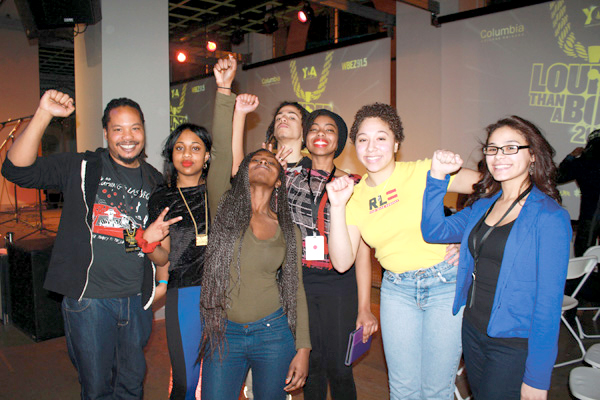
“Brother Mike” Hawkins (at left) and YOUmedia’s Spoken Word team at the
“Louder Than a Bomb” poetry competition in Chicago, March 2013.
Photo courtesy of “Brother Mike” Hawkins.
Taylor Bayless, a librarian with the Chicago Public Library’s YOUmedia youth learning space, runs a podcasting program for teens. Since Bayless had no previous experience with podcasts, she was “muddling through” the learning process along with the kids, teaching herself as she was teaching them. “Someone working with youth has to have the capacity and desire to learn new technology,” says Bayless.
That was one message that came out of an hour-long chat on using social media in libraries, part of a month-long discussion series focusing on teens and the future of school and public libraries.
Sponsored by the Young Adult Library Services Association (YALSA) and Connected Learning, an online learning network, the five programs that ran in May were all about how to engage that most fickle of consumers: teens. During the online discussions, media specialists and librarians who work with young people in new media offered their insight and best practices on how to successfully engage teens and tweens.
Participants were encouraged to comment using the #futureoflibraries Twitter hashtag, watch through Connected Learning’s Google+ Page, and chat over Livestream, where the conversations were archived. Speakers included “Brother Mike” Hawkins, associate director and lead mentor at YOUmedia’s Digital Youth Network.
Getting involved with students early on—and supporting their creative efforts while providing guidance about privacy and fair use—is good policy, says YALSA president-elect Chris Shoemaker, the incoming director of the Rye (NY) Free Reading Room. He recommends talking with teens about the content they produce, such as who may view their posts, the identity they’re projecting online, and what information can be traced back to them. Shoemaker works with students to revise their material before they publish. “I would never want a teenager to pull down content after it’s posted,” he says.
At DYN, Hawkins monitors teens’ social media use rather than polices. That strategy has motivated his young patrons to take ownership and think critically about what they post. When the content is inappropriate, Hawkins and other DYN staff are careful to express their concern in such a way that encourages kids and keeps them engaged—and helps them make good decisions. “I won’t say, ‘Take that down,’” says Hawkins. “But I may say, ‘You want to play this on the radio—but I can’t share this with anyone.’ So you can shape things.”
Ultimately it’s the teens themselves who determine how successfully libraries integrate social media. The real acid test? Whether or not they invite their friends into the branches.
Hawkins says, “We have students coming to the [YOUmedia] studio and taking pictures” who then share the images, attracting the attention of other kids, who ask, “Where you at?” The teens’ own posts can be very effective in promoting the library as a cool place, he adds.
Particularly for libraries lacking a marketing budget, this kind of public relations can work wonders. “If [students] see something cool, and they see a place where adults care about them,” says Hawkins, “they’re going to promote it more than we ever could.”


